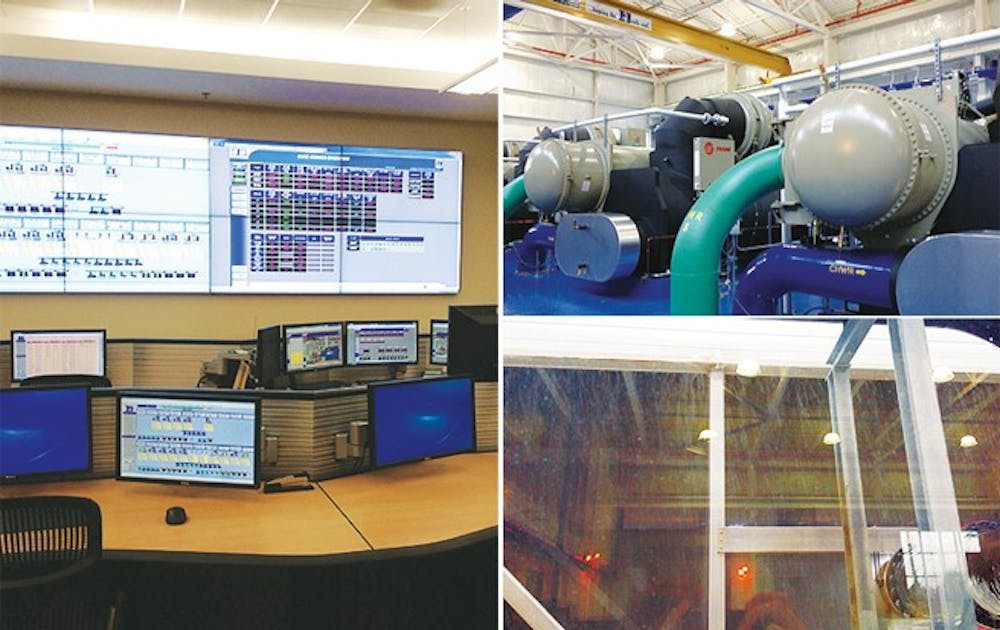Duke’s coolest building just got even cooler.
The Chiller Plant, which cools water for distribution in cooling systems across West Campus, received Leadership in Energy and Environmental Design Gold certification Thursday for sustainable construction practices. It is the second building on Duke’s main campus to achieve LEED Gold—the second highest certification possible—after the East Campus Steam Plant did so in February 2011. The recognition, however, does not take into account further sustainability measures in the facility that are not considered in the LEED process.
Michael Davison, who worked on the building at Flad Architects, said the team was instructed to aim for LEED Silver, but ended up shooting higher.
“In order to get [to gold level], you have to look at the project holistically and see where you can design a building so that the occupants are living and working in an environment that is healthier and better suited for them,” Davison said.
The massive structure sits recessed into the forests around LaSalle Street. Inside, the roar of machinery drowns out nearly any other sound. Titanic blue refrigeration units stand in orderly rows, compressing the tens of thousands of gallons of water that come through the system every day. The plant also houses a 24/7 control room that operates steam, cooling and HVAC utilities across campus.
In order to receive LEED Gold certification, a building must meet 60 out of 110 possible sustainability criteria, in areas from energy use and lighting to the materials used in construction. Duke has 25 LEED-certified buildings, including the Smart Home, which was granted LEED Platinum certification in 2008.
Mechanical spaces and utility components of a building, however, are not explicitly rated for environmental impact in LEED’s system. The LEED Gold certification of the chilled water plant does not include the actual water chillers or any of the green systems used to provide cooling resources to campus.
“LEED’s primary concern is for the occupants in the building, and its goal is a green living and working space for occupants,” Davison said.
Darin Smith, project manager for Duke’s chilled water system, said he is troubled by this policy partly because the chilled water facilities do not explicitly get credit for the efficiency with which they chill water.
Centralized chilled water systems on a campus are markedly more efficient than delocalized air conditioning and cooling system and save campus buildings a great deal of energy, Smith said. Although LEED gives points to all campus projects for having access to centralized chilled water, the specific steps taken for conservation in the chiller systems are not taken into account.
“This is very aggravating for someone like me,” said Smith. “Our stuff never shows up.”
Smith speculated that the 80 percent of the building not considered by the LEED certification process produced enough energy savings for the rest of Duke’s campus to conceivably earn the chilled water plant a LEED Platinum rating—the highest rank, awarded for meeting 80 or more of LEED’s 110 criteria.
“The energy savings being produced by centralizing the utilities in this facility provide a tremendous benefit to campus,” Davison added.
Smith said anything done above LEED standards to improve water chilling efficiency is not explicitly credited, yet plays an important role in the system’s sustainability. For example, the plant utilizes alternative water sources—like roof water—to save 40 to 50 million gallons of water each year, he noted.
Water that becomes too dirty for continued use in the system—backwash—is recycled and refiltered by reverse osmosis, Smith said.
“For every 1,000 gallons [of backwash] that would go down the drain, we probably save about 700,” he said.
Other steps taken by the system yet not credited by LEED include the recovery of condensation that appears on the chilled water coils and water intake from a nearby stream. The plant is also beginning a longer-term project to create a seven-acre on-campus pond for storage and use of runoff collected from Duke’s campus.
“At the end of the day, even though we might not get points, we still know that we’ve done the right thing,” Smith said.
Get The Chronicle straight to your inbox
Signup for our weekly newsletter. Cancel at any time.

